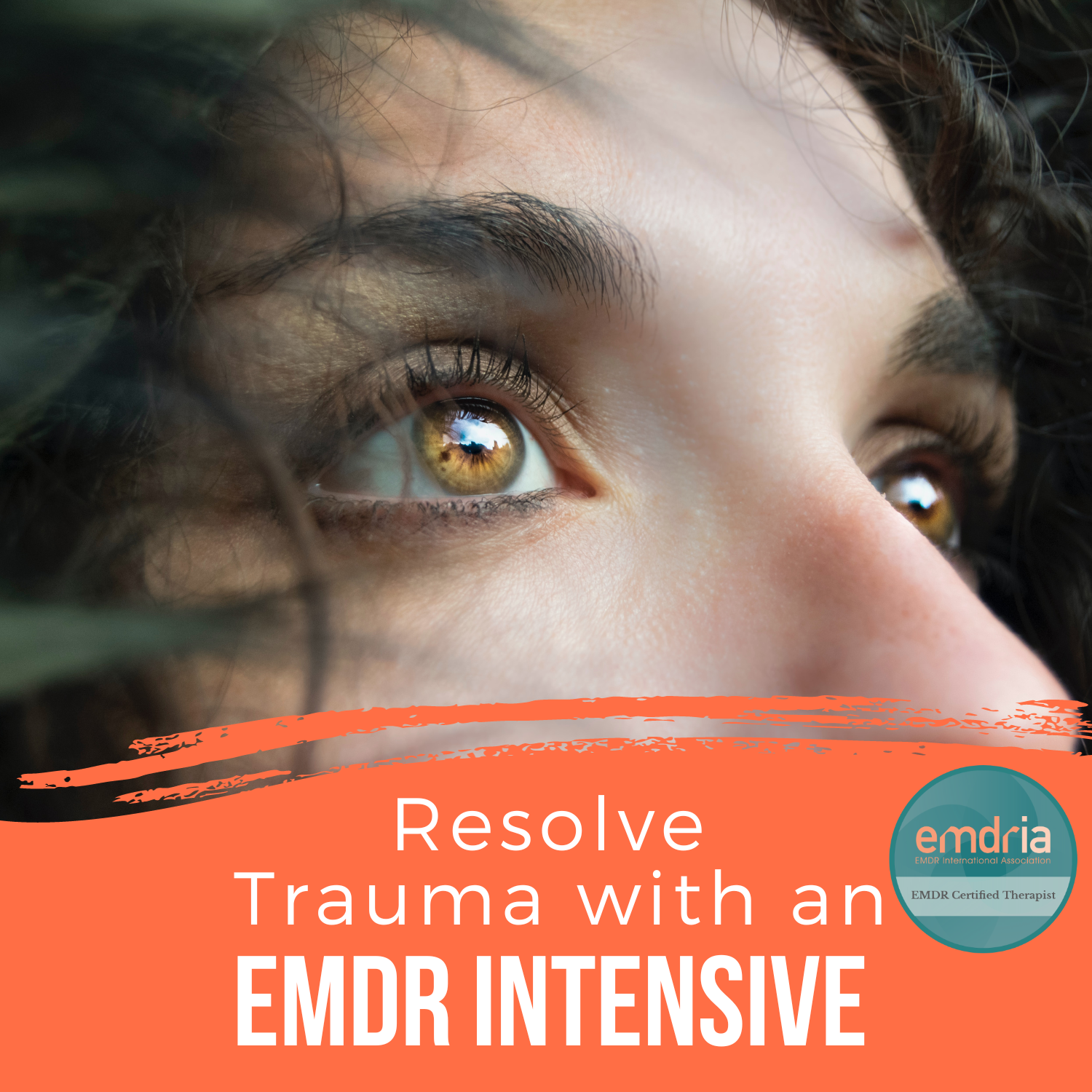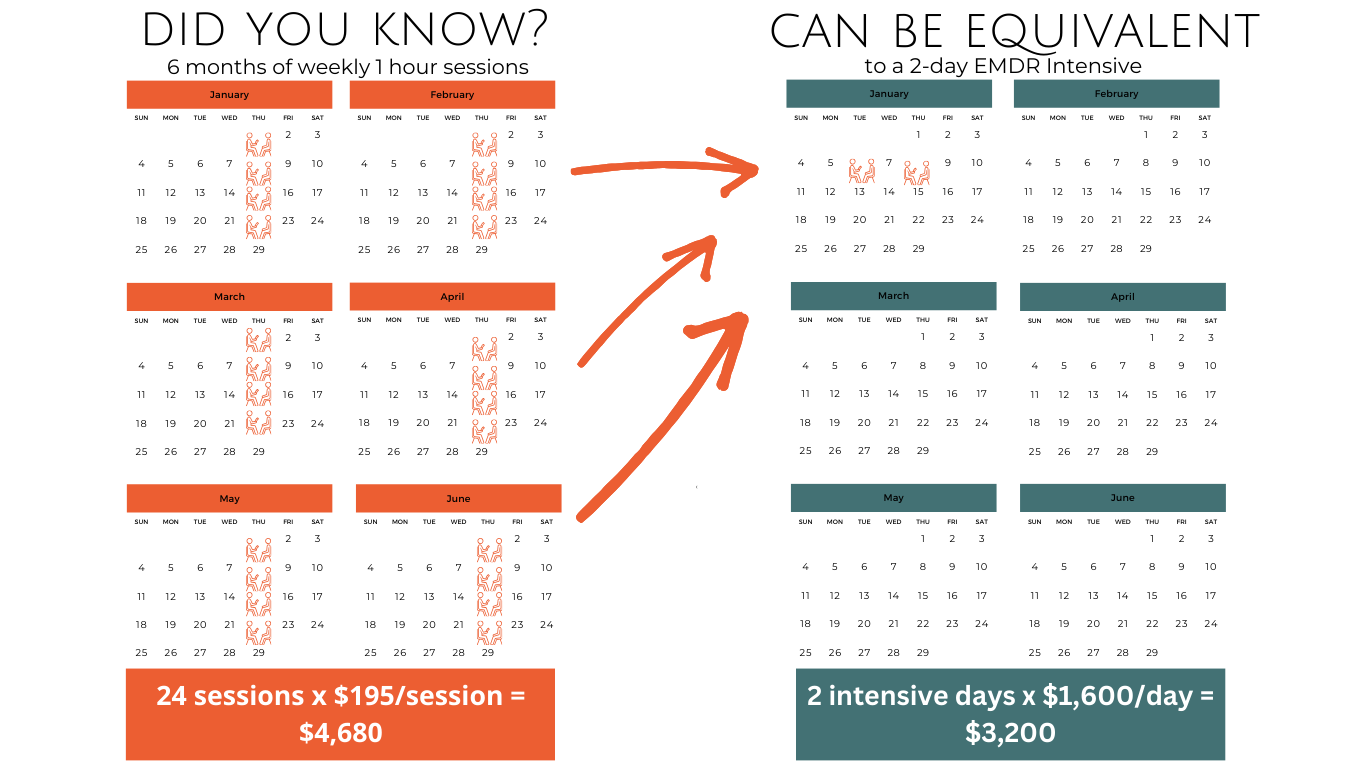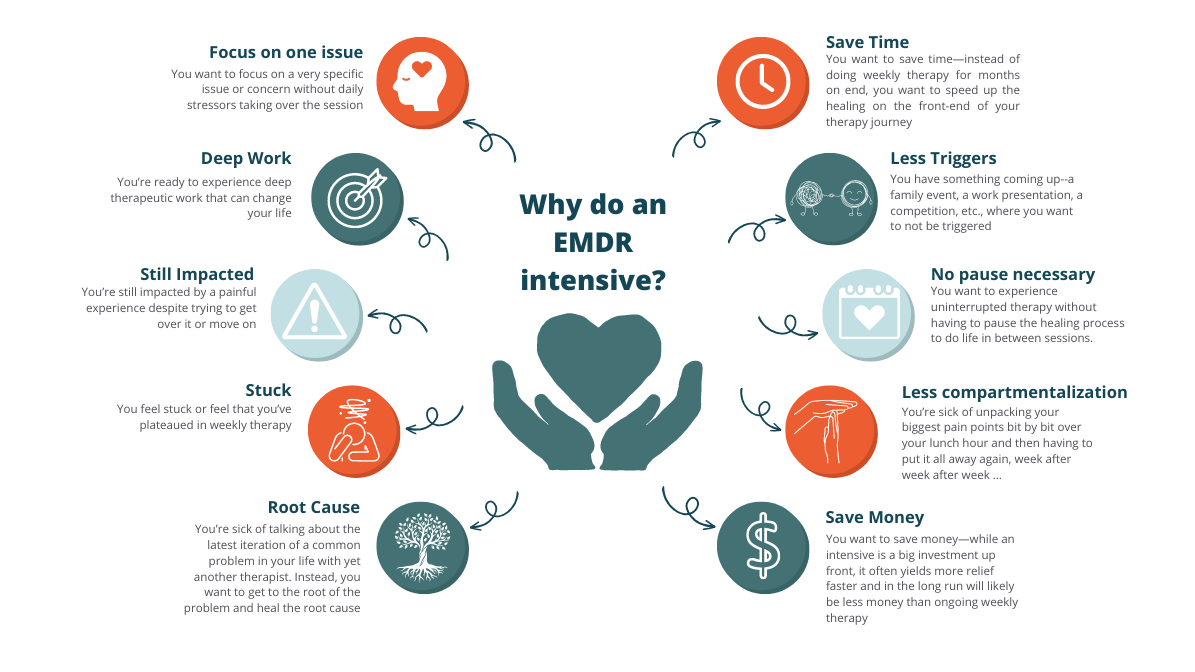EMDR Intensives
FEEL BETTER FASTER WITH EMDR THERAPY INTENSIVES
Tired of going through your deepest pain points week after week in traditional therapy?
Have you been meaning to start therapy for a while now, but you’re already so busy it seems impossible to fit in a weekly therapy appointment?
Is there something you know you need to work on but you’ve been avoiding therapy because it just feels too overwhelming to talk about week after week?
Do you need alleviation from symptoms fast and don’t want to spend months in the traditional, weekly therapy model before feeling better?
I have great news for you: EMDR therapy intensives can propel your therapy progress, allowing you to delve deeper and feel better faster than weekly therapy allows.


WHAT IS AN EMDR THERAPY INTENSIVE?
EMDR therapy intensives are an accelerated format of therapy that helps people get to the root of their problems and feel better faster.
Instead of weekly 50 minute counseling sessions, an intensive allows us to ditch the time constraints of traditional therapy so that we can take the time needed to make substantial progress in EMDR—whether that requires 3 hours or spans across 3 days.
Intensives allow us unhurried time to process trauma, heal negative core beliefs, recover from addiction, and accelerate your progress towards your therapy goals.
EMDR Intensive Schedule Options
An EMDR Intensive consists of 1-4 full day sessions, 9am-5pm (with a 1 hour lunch break)
Together, we will identify what days work best for you.
Weekdays: $1,600/day
Saturday & Sunday: $2,000/day
HOW DO EMDR INTENSIVES WORK?
Before the intensive:
We will meet for a pre-intensive intake session to clarify your goals. We will talk about what your life looks and feels like now vs. how you want it to look and feel after you’ve met your therapy goals. We’ll also learn coping skills to use during EMDR therapy to help the work feel more manageable.
During the EMDR Intensive:
There’s a lot going on but it all boils down to these two priorities:
- To make the painful stuff hurt less and
- Help the good stuff feel even better
If you want to know more about how this happens, read through my EMDR page here.
After the intensive:
We will meet for a post-intensive session to reflect and integrate the benefits gained into your daily life. Some clients choose to end the relationship at this time, while some choose to do another intensive or continue with weekly or monthly standard therapy.
Why do an EMDR Intensive?


EMDR Explained

Are you ready to heal your past?
Frequently Asked Questions about EMDR Intensives
Who could benefit from an EMDR Intensive?
- Someone who is feeling stuck with their current therapist.
- Someone who loves their current therapist but wants to work for a short focused time with an EMDR therapist to process specific memories
- Your schedule makes it difficult to commit to weekly hour-long sessions
- Teachers who have the summers off.
- People who have PTO to use up.
- Someone who has been putting off going to therapy because they are afraid it will be too overwhelming to process their past while also living their regular life
- Someone who doesn’t want to be in therapy for months or years
- You’re busy and weekly therapy appointments feel stressful rather than supportive
If I haven’t experienced trauma, would I benefit from EMDR?
While EMDR began as a trauma treatment, it has evolved and is not just used for trauma anymore. EMDR can be used to treat:
- Negative core beliefs about yourself (such as: I’m not good enough, I have to be perfect)
- Depression
- Anxiety
- Social anxiety
- Performance anxiety
- Addiction (substance abuse, food, technology, behaviors)
- Phobias
- PTSD
- Acute pain
- Complicated grief
- Eating disorders
- Panic attacks
- Car accidents
- Parenting concerns
- Codependency
- Self-esteem issues
- recurring self-defeating patterns of behavior and negative thinking
- Improving body image and self-esteem
- Reducing or eliminating distressing emotions related to painful memories
How does EMDR work for performance enhancement?
EMDR is effective in preparing for a big work presentation, a hard conversation with someone you love, a tough parenting moment, an athletic event, or anywhere you need more confidence!
Are intensives online or in person?
EMDR intensives can be done either online or in-person at my office.
Online intensives are available for residents of the states I’m licensed in: Colorado, Texas, and New Jersey. In-person intensives are available to anyone who can travel to Denver, CO.
Do I have to live in Colorado to do an EMDR intensive?
My practice is located in Denver, Colorado, but that doesn’t mean you have to live in Colorado. Clients can travel from anywhere in the world to Denver to spend a few days with me in an Intensive and then return home to their daily lives.
This is a lot of info. Boil it down for me: what is an EMDR intensive?
An EMDR intensive is an extended and concentrated therapy session where you do a series of EMDR sessions over a longer period of time than a typical 50 minute session. Typically, an intensive will span several consecutive days. This format aims to accelerate the therapy process so you get deeper, longer lasting results, faster.
How long does an EMDR intensive last?
The length of the intensive is tailored to each individual’s needs. However, below is a few of my most common intensive schedules:
- Three 3 hour sessions in the same week on a Monday, Wednesday, Friday
- Three 3 hour sessions in the same week on a Tuesday, Wednesday,Thursday
- Three 3 hour sessions in the same week on a Thursday, Friday, Saturday
Who isn’t suitable for an EMDR intensive?
While EMDR can be effective for many people, there are some dissociative disorders and certain mental health conditions that may require careful assessment and preparation before an EMDR intensive.
Who is a good fit for an EMDR intensive?
To reprocess traumatic memories using EMDR, clients should have the ability to:
- be present in their mind and body to notice what’s happening during the session
- be able to feel worse for a short period
- be able to tolerate some distress
- be emotionally equipped to avoid panic
- have established coping skills and outside support
How effective is an EMDR intensive compared to regular EMDR sessions?
EMDR intensives aim to achieve similar therapeutic outcomes as traditional EMDR but in a shorter time frame. Research suggests that intensives can be particularly effective for certain individuals and types of trauma, but individual responses may vary.
What does the research say about EMDR Intensives?
- Intensive application of trauma-focused therapy seems to be well tolerated in patients with PTSD, enabling faster symptom reduction with similar, or even better, results, while reducing the risk that patients drop out prematurely. Learn more here and here.
- Intensive EMDR treatment is feasible and is indicative of reliable improvement in PTSD symptoms in a very short time frame. Learn more here.
- An intensive program using EMDR therapy is a potentially safe and effective treatment alternative for complex PTSD. Learn more here.
- The economic benefit of intensive trauma treatment is compelling: even compared to other trauma therapy, the intensive format may decrease treatment time, because of time not spent on a) checking in at the beginning of each session, b) addressing current crises and concerns, c) focusing on stabilizing and coping skills that the client won’t need after trauma healing, or d) assisting the client in regaining composure at the end of the session. Learn more here.
If I already have a therapist, can I do an EMDR intensive as adjunct therapy?
Yes! I am more than happy to collaborate with your ongoing therapist. EMDR intensive treatment can pair very well with ongoing therapy with another provider. EMDR can be used to process past trauma or adverse experiences from the past that may have become sticking point in your current life. EMDR can help provide shifts in healing that facilitate your ongoing treatment with your primary therapist. Sometimes clients can cognitively undertand something but they struggle to fully integrate this knowing into their heart and bodies, and an EMDR intensive can help you achieve more thorough integration. We will identify what format is best for you during your initial consultation.
What can I expect to accomplish in a half-day intensive?
A half-day intensive offers many resources and can help to either increase performance and confidence, or significantly decrease the devastating effects of single event trauma (e.g. negative cognitions, disturbing emotions and body sensations). While significant healing can occur in one half-day intensive, Complex PTSD deserves more treatment than one half-day intensive and is usually better served by longer intensives unless significant work and EMDR has been done previously.
What can I expect to accomplish in a 2-day intensive?
Participating in a 2-day EMDR intensive presents the opportunity for impactful change more efficiently than weekly, 50-minute sessions or even one half-day intensive. In a 2-day (full days) intensive, I would generally expect to complete at least some of the 8 phases of EMDR on at least one target; some may move significantly faster than this, and some may move slower. The speed is generally dependent on each individual person’s processing speed and the complexity of their memory networks and associated core beliefs.
Frequently Asked Questions about EMDR Therapy
What is EMDR?
EMDR Therapy has gotten worldwide attention for helping millions of people heal from PTSD (Post Traumatic Stress Disorder) caused from traumatic events such as: childhood abuse, emotional abuse, rape, sexual abuse, auto accidents, and combat. EMDR Therapy can also help people heal after events that have been disturbing such as; postpartum depression, traumatic birth, divorce, life transitions, grief, anxiety, depression, and much more.
EMDR can work on such a wide range of issues because of the way it helps our brains integrate and process past events. When we experience a trauma, the brain stores the disturbing event in a memory network in a way that isolates it and prevents it from connecting with more useful, adaptive information. So instead of learning and resolving the memory, the old material just keeps getting triggered over and over again. In short, it’s gotten “stuck” in our neural networks in our brains and therefore keeps triggering difficult reactions in the present.
In another part of your brain, in a separate network, is most of the information you need to resolve it. It’s just prevented from linking up to the old stuff. Once we start processing with EMDR, the two networks can link up and new information can come to mind and resolve the old problems.
EMDR is designed to help a person process these stuck pieces so that the memory is no longer triggering present day reactions and difficulty. It does this by activating our body’s healing system to help process and integrate the information that got stuck when the trauma happened.
Once the new connections are made, the negative emotions should diminish. I know it can be scary to sit with these old traumatic memories, so one thing I want you to know is that by doing EMDR, we aren’t adding anything negative to what’s already there. Instead, we are opening up some neural pathways that will allow the tough negative stuff to drain out and diminish. This will help you resolve the memory. EMDR will not erase the memory; rather you will be able to remember the story without all the emotional charge that was distressing before the treatment.
In EMDR Therapy we are working both with the challenges of the past as well as ongoing strengthening and resourcing. Through this focus of healing the past AND strengthening your ability to handle the future, clients are often able to achieve lasting healing that spreads to multiple areas of their life.
How can EMDR help with so many types of issues?
In another part of your brain, in a separate network, is most of the information you need to resolve the tough memory. It’s just prevented from linking up to the old stuff. Once we start processing with EMDR, the two networks can link up and new information can come to mind and resolve the old problems.
EMDR is designed to help a person process these stuck pieces so that the memory is no longer triggering present day reactions and difficulty. It does this by activating our body’s healing system to help process and integrate the information that got stuck when the trauma happened.
Once the new connections are made, the negative emotions should diminish. I know it can be scary to sit with these old traumatic memories, so one thing I want you to know is that by doing EMDR, we aren’t adding anything negative to what’s already there. Instead, we are opening up some neural pathways that will allow the tough negative stuff to drain out and diminish. This will help you resolve the memory. EMDR will not erase the memory; rather you will be able to remember the story without all the emotional charge that was distressing before the treatment.
In EMDR Therapy we are working both with the challenges of the past as well as ongoing strengthening and resourcing. Through this focus of healing the past AND strengthening your ability to handle the future, clients are often able to achieve lasting healing that spreads to multiple areas of their life.
Is EMDR going to make me re-live what happened to me?
In an EMDR session, I ensure that clients are grounded in the safety of the present moment in my office. This allows the client to process their past trauma while staying safe and grounded. Think of it this way: during EMDR, you’ll have one foot in the past and one foot in the present at all times. You are always in control of an EMDR session and can stop at any time.
How does EMDR work?
Researchers are still studying this, but so far, our best guess is that using DAS elicits an orienting response, which means that the DAS will immediately have a physiological and behavioral change as your body responds to the stimulation.
I know this language is a bit intimidating. In other words, this means that during EMDR sessions, you’ll be able to process through memories in a way that talk therapy often can’t achieve. This is because you are healing these memories with a body- and brain-based intervention.
This response is based on Francine Shapiro’s Adaptive Information Processing (AIP) theory, which is the system in our bodies that helps us heal. Similar to the body’s natural move toward healing after a physical injury, AIP suggests that psychologically the individual also naturally moves toward healing after a trauma.
This is really just a fancy way of saying that DAS can cause you to deeply relax, which will help those adaptive connections to happen.
When you’re doing EMDR, sometimes it can be a bit intense as you face these old memories, because you’ve been working so hard to not face it for all of these years. But, think of it this way — the old stuff is effecting you in so many different ways every day —once we process through the old stuff, while some unpleasant sensation may arise during EMDR, that is a sign that the old material is leaving the nervous system.
How was EMDR discovered?
Dr. Shapiro began to study and use her new protocol with people suffering from PTSD (Post Traumatic Stress Disorder) and found that the people with PTSD after receiving several EMDR Therapy sessions found that their symptoms decreased and they started to feel better. Since then, EMDR has become one of the most researched therapy models to treat trauma. It is now one of the most recommended and researched psychotherapeutic treatments for trauma.
What is Trauma?
Dr. Gabor Maté explains trauma in a beautiful way. He said:
“The essence of trauma is that, as a result of the overt abuse or neglect, or because of the relational trauma, we lose the connection to our essence. That’s what the trauma is. The trauma is not what happened; the trauma is not that I was raped, the trauma is not that I was abandoned, the trauma is not that I was hit, the trauma is not that my parents didn’t know how to listen to me.
That’s not the trauma; the trauma is that, as a result of that, I lost the connection to myself. Hence, I lost the connection to my essential qualities: my joy, my vitality, my clarity, my wisdom, my power, my strength, my courage. That’s the trauma!”
Because we are human, most of us have experienced trauma, or a disconnection to our essence, in some way. EMDR can help us find our way back to ourselves.
IS EMDR Therapy Right for You?
People tend to think that EMDR only helps people who suffer from severe experiences like auto accidents, war, sexual abuse, and rape. If you have suffered from these traumas, EMDR might be very helpful for you. But other issues can also be helped with EMDR—such as anxiety, depression, family problems, relationship problems, parenting difficulties, difficult transitions, etc.
Take the brief quiz below to find out if you might benefit from EMDR Therapy.
What is the benefit of choosing a *Certified* EMDR therapist?
As a Certified EMDR therapist, I have chosen to continue my EMDR training and consultation beyond what is necessary to ensure you receive the best care possible. Here are the differences between a therapist trained in EMDR and a certified EMDR therapist.
EMDR Training: The Basics
EMDR training is a lengthy process. There are many places offering EMDR training, but only EMDR International Association (EMDRIA) approved trainings include the theoretical basis for the model, in-depth instruction on all 8 phases, stabilization techniques and 20 hours of practice sessions (practicum) and 10 hours of post-training consultations. Many platforms offer quick (as short as 8 hour) trainings on what EMDR is, but taking a training about EMDR is not the same as being trained in EMDR! Most EMDRIA approved trainings consist of two separate 3 day in person or live web-based workshops. Over the course of the first 3 days, which is 20 hours (10 hours instruction, 10 hours practicum), trainees are taught the basics of how to use EMDR, and are able to begin using EMDR while receiving consultation. After a trainee has taken the second weekend (another 20 hours), and completed required consultation hours, they are considered to be trained in EMDR. To be fully trained in EMDR is 50 hours of training, in addition to whatever graduate degree your therapist holds to be able to provide therapy.
EMDR Certification
EMDR certification is an even lengthier process. At our practice we have both clinicians who are certified and clinicians who are working toward certification. Both are able to use EMDR with clients. EMDR Certification is a designation that allows therapists to be listed on the EMDRIA website as certified. This allows clients to know that their clinician has put in extra hours of training and consultation. To be EMDR Certified a therapist must:
-
Have a full independent license to practice as a therapist
-
Be fully trained in EMDR
-
Have completed 20 hours of consultation specific to EMDR from an EMDRIA approved consultant (this is often in addition to regular clinical consultation)
-
Submit a letter of recommendation from their EMDRIA approved consultant
-
Submit two letters of recommendation from colleagues or peers
-
Complete 12 hours of advanced EMDR training
-
Submit a notarized statement of practice and experience
Depending on the frequency of consultation, this process can take up to several years after training is complete.
